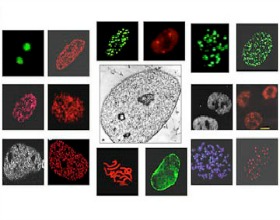Nuclear Structure and Function

Regulatory machinery for vital cellular processes, including transcription, replication, repair, and apoptosis, as well as biological control of proliferation, lineage commitment, phenotype, tumor promotion, and tumor suppression are organized in distinct nuclear microenvironments. Our group has identified molecular and epigenetic mechanisms that govern localization of lineage-determining regulatory proteins to subnuclear sites of transcription. Applying a combination of genetic, biochemical, and in situ cell biological techniques supported by advanced bioinformatic analysis, we have identified unique trafficking signals in Runx proteins, master regulators of osteogenesis, hematopoiesis, and neurogenesis/gastro-intestinal development. Disruption of physiological localization of proteins to distinct subnuclear sites (e.g., ‘Runx foci’) results in altered transcriptional programs ultimately leading to compromised cell growth and differentiation. Clinical relevance of these findings is emphasized by aberrant subnuclear targeting of these proteins under a variety of pathological conditions that include acute myelogenous leukemia, as well as breast and prostate cancers. Currently, we are using multiomic genomic (high-throughput DeepSeq and single cell analysis) and proteomic Bio ID and high-resolution mass spec approaches to define mechanisms that relate subnuclear organization of regulatory factors and gene loci with biological control of cell function and pathological disruption in cancer. Nuclear microenvironments are being explored that support the function of Runx proteins. We are investigating subnuclear organelles including Histone Locus Bodies (see Genetic and Epigenetic Regulation of Gene Expression). Utilizing a recently developed degron approach to rapidly and selectively degrade the RUNX1 transcription factor, which is an obligatory tumor suppressor in normal mammary epithelial cells, we are, for the first time, defining initial parameters of control that epigenetically mediate an epithelial to mesenchymal transition and initiation of breast cancer tumor genesis.
Our laboratory examines the chromatin structure and higher-order chromatin organization of genes that mediate cell cycle control (e.g., histone genes) and osteoblast differentiation (e.g., osteocalcin and Runx2 genes) (see Musculoskeletal Biology and Pathology).
Landmark Papers
- Glencer A; Ramalingam K; Schindler N; Hidetoshi M; Ghule P; Lee K; Nachmanson D; Officer A; Harismendy O; Stein JL; Stein GS; Evans M; Weaver D; Yau C; Hirst GL; Campbell MJ; Esserman LJ; Borowsky AD. Tumor microenvironmental determinants of high-risk DCIS progression. Submitted.
- Gordon JAR, Tye CE, Banerjee B, Ghule PN, van Wijnen AJ, Kabala FS, Page NA, Falcone MM, Stein JL, Stein GS, Lian JB. LINC01638 sustains human mesenchymal stem cell self-renewal and competency for osteogenic cell fate. Sci Rep. 2023 Nov 20;13(1):20314. doi: 10.1038/s41598-023-46202-z. PMID: 37985890; PMCID: PMC10662126.
- Ghule PN, Boyd JR, Kabala F, Fritz AJ, Bouffard NA, Gao C, Bright K, Macfarlane J, Seward DJ, Pegoraro G, Misteli T, Lian JB, Frietze S, Stein JL, van Wijnen AJ, Stein GS. Spatiotemporal higher-order chromatin landscape of human histone gene clusters at histone locus bodies during the cell cycle in breast cancer progression. Gene. 2023 Jul 1;872:147441. doi: 10.1016/j.gene.2023.147441. Epub 2023 Apr 23. Erratum in: Gene. 2023 May 11;873:147469. PMID: 37094694; PMCID: PMC10370284.
- Gordon JAR, Evans MF, Ghule PN, Lee K, Vacek P, Sprague BL, Weaver DL, Stein GS, Stein JL. Identification of molecularly unique tumor-associated mesenchymal stromal cells in breast cancer patients. PLoS One. 2023 Mar 20;18(3):e0282473. doi: 10.1371/journal.pone.0282473. PMID: 36940196; PMCID: PMC10027225.
- Tye CE, Ghule PN, Gordon JAR, Kabala FS, Page NA, Falcone MM, Tracy KM, van Wijnen AJ, Stein JL, Lian JB, Stein GS. LncMIR181A1HG is a novel chromatin-bound epigenetic suppressor of early stage osteogenic lineage commitment. Sci Rep. 2022 May 11;12(1):7770. doi: 10.1038/s41598-022-11814-4. PMID: 35546168; PMCID: PMC9095685.
- Nachmanson D, Officer A, Mori H, Gordon J, Evans MF, Steward J, Yao H, O'Keefe T, Hasteh F, Stein GS, Jepsen K, Weaver DL, Hirst GL, Sprague BL, Esserman LJ, Borowsky AD, Stein JL, Harismendy O. The breast pre-cancer atlas illustrates the molecular and micro-environmental diversity of ductal carcinoma in situ. NPJ Breast Cancer. 2022 Jan 13;8(1):6. doi: 10.1038/s41523-021-00365-y. PMID: 35027560; PMCID: PMC8758681.
- Andrew J. Fritz, Mohammed El Dika, Rabail H. Toor, Princess D. Rodriguez, Stephen J. Foley, Rahim Ullah, Daijing Nie, Bodhisattwa Banerjee, Dorcas Lohese, Karen C. Glass, Seth Frietze, Prachi N. Ghule, Jessica L. Heath, Anthony N. Imbalzano, Andre van Wijnen, Jonathan Gordon, Jane B. Lian, Janet L. Stein, Gary S. Stein. Epigenetic-mediated regulation of gene expression for biological control and cancer: cell and tissue structure, function, and phenotype, Nuclear, Chromosomal, and Genomic Architecture in Biology and Medicine. Switzerland: Springer Nature. 2022. In print.
- Nirala NK, Li Q, Ghule PN, Chen HJ, Li R, Zhu LJ, Wang R, Rice NP, Mao J, Stein JL, Stein GS, van Wijnen AJ, Ip YT. Hinfp is a guardian of the somatic genome by repressing transposable elements. Proc Natl Acad Sci U S A. 2021 Oct 12;118(41):e2100839118. doi: 10.1073/pnas.2100839118. PMID: 34620709; PMCID: PMC8521681.
- Zaidi SK, Young DW, Javed A, Pratap J, Montecino M, van Wijnen A, Lian JB, Stein JL, Stein GS. Nuclear microenvironments in biological control and cancer. Nat Rev Cancer. 2007 Jun;7(6):454-63.
- Vradii D, Zaidi SK, Lian JB, van Wijnen AJ, Stein JL, Stein GS. Point mutation in AML1 disrupts subnuclear targeting, prevents myeloid differentiation, and effects a transformation-like phenotype. Proc Natl Acad Sci U S A. 2005 May 17;102(20):7174-9.
- Javed A, Barnes GL, Pratap J, Antkowiak T, Gerstenfeld LC, van Wijnen AJ, Stein JL, Lian JB, Stein GS. Impaired intranuclear trafficking of Runx2 (AML3/CBFA1) transcription factors in breast cancer cells inhibits osteolysis in vivo. Proc Natl Acad Sci U S A. 2005 Feb 1;102(5):1454-9.
- Young DW, Zaidi SK, Furcinitti PS, Javed A, van Wijnen AJ, Stein JL, Lian JB, Stein GS. Quantitative signature for architectural organization of regulatory factors using intranuclear informatics. J Cell Sci. 2004 Oct 1;117(Pt 21):4889-96.
- McNeil S, Zeng C, Harrington KS, Hiebert S, Lian JB, Stein JL, van Wijnen AJ, Stein GS. The t(8;21) chromosomal translocation in acute myelogenous leukemia modifies intranuclear targeting of the AML1/CBFalpha2 transcription factor. Proc Natl Acad Sci U S A. 1999 Dec 21;96(26):14882-7.